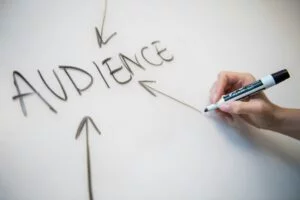The principle to “begin with the end in mind” proves helpful in various ways.1 Your approach to your research is no exception. The clearer the idea you have of what you want to produce, the easier you’ll find it to chart your path there. Exactly what you aim to produce, however, isn’t the first question.
First Who, Then What

What you want to produce is determined by the audience for whom you’re producing it.2
To illustrate this principle, think of an academic journal article you’ve read recently. Then imagine the author presenting the article in pretty much its final published form at an academic conference.
What does that presentation look like? The presenter probably
- does a good deal of reading to the audience from his or her manuscript that includes a number of technical details,
- skips some portions of the argument for the sake of time, and then maybe
- hurries through to conclude before time runs out.
In this scenario, the presentation is pretty creditable even if it doesn’t get incredibly high marks for delivery.
But now, imagine the same presentation in the context of a church Bible class rather than an academic conference. The presentation’s content and delivery might be identical. But the audience is liable to receive it much less favorably because it doesn’t fit the context.
It doesn’t prioritize who the audience is in shaping what the presentation is. In the first case, the presenter may get invited back to speak because the presentation was good. In the second, the outcome may be very different—even though the presentation was the same in both cases.
Conclusion
This hypothetical (but definitely true-to-life) example illustrates that, before you can decide what your research should be, you first need to decide who it’s for.
That who will necessarily shape any quality what. If what you produce doesn’t find an interested who to engage with it, it won’t do much good.3
So, before you get too far along with what you want to produce in any given project, it’s always worth getting clear on who that research is for.
- Header image provided by Glen Carrie. For more about beginning with the end in mind, see Stephen R. Covey, The 7 Habits of Highly Effective People: Powerful Lessons in Personal Change, 25th anniversary ed. (affiliate disclosure; New York: Simon & Schuster, 2013), 102–53. ↩︎
- Here, I’m particularly playing off of and adapting the discussion of Jim Collins, Good to Great: Why Some Companies Make the Leap … and Others Don’t (affiliate disclosure; New York: HarperBusiness, 2001), 41–64. Image provided by Melanie Deziel. ↩︎
- On the importance of the audience in determining a rhetorical situation, see also Lloyd F. Bitzer, “The Rhetorical Situation,” Philosophy and Rhetoric 1 (1968): 1–14. ↩︎

Leave a Reply